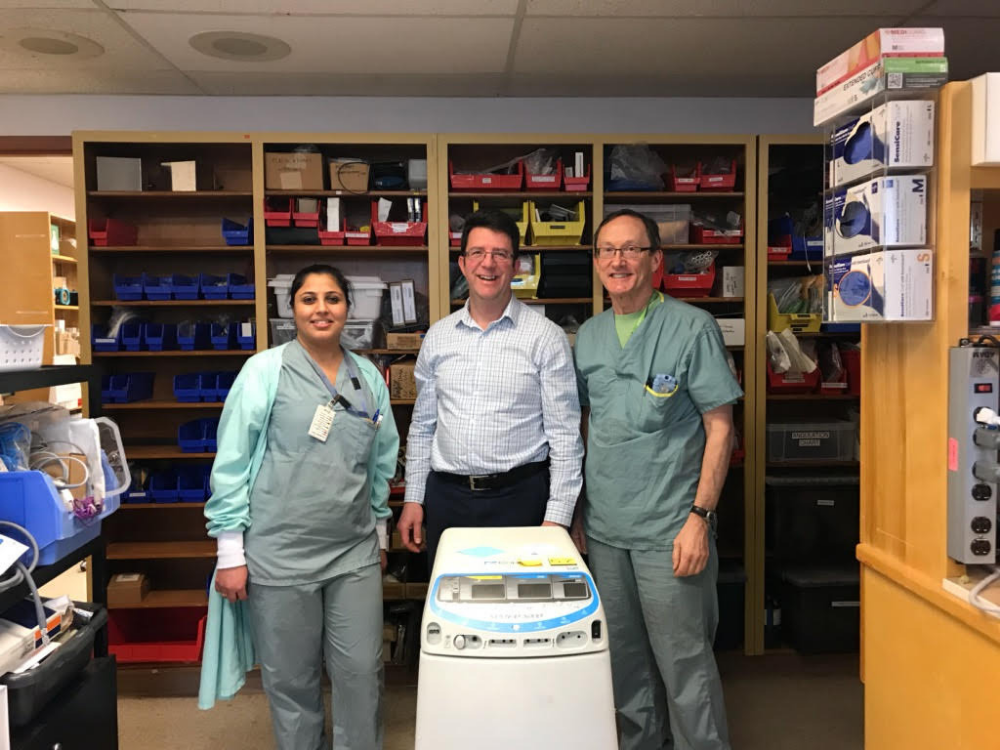A Profile of the RJH Biomedical Engineering Department
When you or a loved one needs care at Royal Jubilee or Victoria General hospitals, every crucial piece of data, every diagnostic test and pivotal intervention relies on leading-edge technology in the hands of our doctors, nurses, and caregivers to make us better.
But what happens when that technology needs to be updated or when it breaks down? The Biomedical Engineering Department plays a vital role in patient care, maintaining the equipment that Island Health caregivers need to save lives.
“Patient care has evolved over the last century to depend on technology,” says Martin Poulin, Director of Biomedical Engineering and a 22-year employee at Island Health. “We make sure that technology is working when it needs to.”
The Biomedical Engineering Department provides support for medical devices at all acute care and community hospitals within Island Health. This support includes a timely response to repairs for over 18,000 medical devices—everything from thermometers, infusion pumps, and anesthetic machines to MRIs. Involved in the entire life-cycle of clinical technology, the Biomedical Engineering Department supports every aspect of its management, including planning, prioritization, procurement, installation, maintenance, and disposal.
“We tend to keep a low profile and don’t often broadcast what we do,” admits Martin. “We apply engineering design and principles to medical technology in healthcare.”
Since the Biomedical Engineering team collaborates with Island Health to address needs for all departments—from Purchasing and Nursing to Infection Control—strong interpersonal, customer-focused skills and extensive planning are integral to the work they do. As the interface between the clinical and technical worlds, they not only understand how a doctor or nurse applies a device when caring for a patient, they know how it works and what infrastructure is required for the equipment to work. They train clinicians and help them specify and evaluate devices, review purchase proposals, implement, maintain, and repair the technology, and take apart retired equipment for recycling. Their expertise extends beyond electronics: they provide multidisciplinary technical services including plumbing for dialysis, electrical and mechanical for X-ray systems, information technology, and cyber security.
“You never know what you’ll look at day-to-day,” says Ted MacLaggan, Manager of Biomedical Engineering for the Central/North Island. “You need to be a jack of all trades. Our technologists thrive on that.”
Biomedical Engineering employs three professional engineers, Martin Poulin, Ted MacLaggan and Gordon Jasechko, and one in training, Miguel Antonio. In total, there are 45 technologists at the acute care sites of Island Health. When new staff are hired, they receive training to become experts in particular areas of technology: for example, medical imaging, renal, or the operating room. These teams specialize in dialysis, patient monitor systems, respiratory therapy, anesthesia devices, lasers, cameras, electrosurgery units, and more.
“Our staff maintain one-on-one relationships with caregivers,” says Martin. “When a doctor, nurse or staff person has a problem, they call us directly. This helps us respond effectively. Our technologists prioritize their own time by identifying with the caregivers what needs to be turned around quickly.”
Every week, Ted reviews a summary of alerts sourced from medical device clients and vendors across North America. Where needed, his team upgrades operating instructions and changes software or parts. When something goes wrong—a bug or glitch—newer equipment displays an error code and caregivers contact their technologist.
Whether an infusion pump, a patient monitor, or an entire operating room, the equipment is extremely reliable with additional units in place should one break down. For this reason, the Biomedical Engineering Department typically only works after hours if the patient monitoring system goes down. “We don’t, thankfully, have many emergencies,” says Ted.
Although largely behind the scenes, Biomedical Engineering’s role in healthcare only continues to grow. “We’re the bridge between the clinical and technical worlds,” says Ted. “They explain what they need and we translate this into technical solutions.”
PATIENT MONITORING SYSTEM
Through our $3.5 million You Are Vital campaign in the fall of 2018, the Victoria Hospitals Foundation raised funds toward a major upgrade of the patient monitoring system at Royal Jubilee and Victoria General hospitals, including new central monitors and an upgrade of hardware and software systems that connect to monitors and information systems around the hospitals.
The new system alerts caregivers of changes or trends in a patient’s symptoms, combining technology with caregivers’ expertise so they can take immediate, informed action and make the right decisions, in the right moment for the best outcome. An essential communication tool that benefits critically ill patients, the system allows a centralized, consolidated view of each patient’s current status.
“People see what’s physically in the patient’s room without realizing there is extensive infrastructure behind the wall: IT networks, medical grade networks and database servers,” says Ted, who led the system’s planning and installation. “Highly configurable, with many different pieces and components, to install and upgrade these systems successfully requires immense planning. These systems are incredibly complex.”
Whether in emergency, intensive, or cardiac care, patients are monitored by bedside and portable monitors that record their vital signs—heart rate, oxygen saturation, respiratory rate, exhaled carbon dioxide, blood pressure and temperature—and record a patient’s heart activity. Wireless coverage at Royal Jubilee and Victoria General hospitals allows care teams to monitor patients remotely: a surgical patient with a cardiac arrhythmia who is up and walking, headed to diagnostic imaging, or moved from intensive care to the cardiac unit is monitored continuously as they recover.
“We plan meticulously how we’re going to roll out the patient monitoring system—which departments go first—because installation will require down time,” says Ted. “With every project, we work closely with Island Health clinicians to minimize the impact on patient care.”
“This is a life safety system. If a patient crashes, stops breathing or has cardiac arrest, this equipment alerts clinicians there is a problem,” says Martin.






Thank you Martin for taking the time to reach out to others and to explain the unique and important roles our BME Technologists and Engineers have in Healthcare and Island Health in particular. Well Done!
Amazing work! I am so grateful for your team and to be working alongside Biomedical Engineering.
Technical Coordinator, Renal Services
Martin, Ted, Gordon – Great article showcasing the important role that BME does quietly behind the scenes. Take a bow!